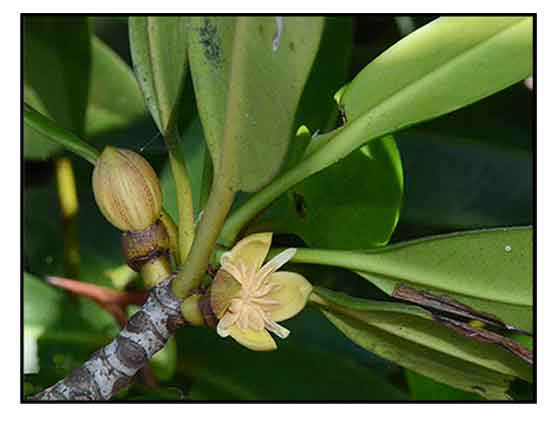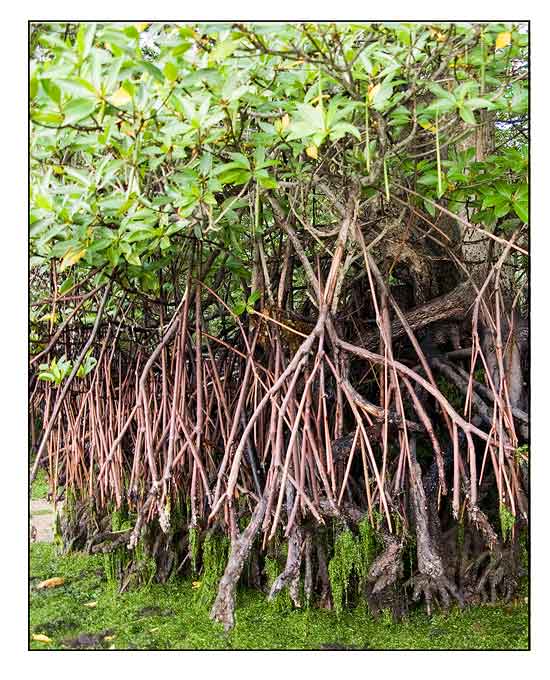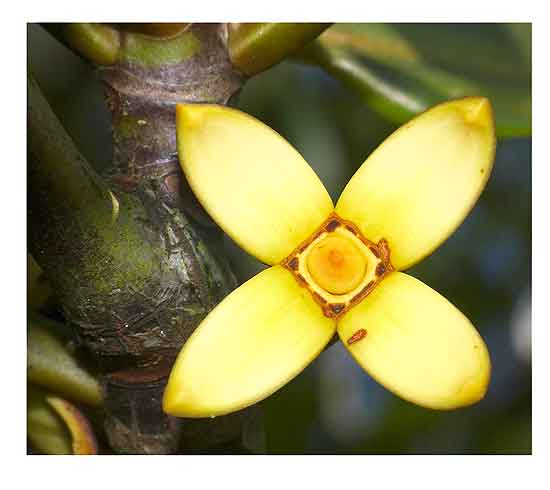 Gen info Gen info
- Rhizophora is a genus of tropical mangrove trees, sometimes collectively called true mangroves.
- Etymology: The genus name Rhizophora derives from Greek words rhiza, meaning "root", and phoros, meaning "bearing", referring to the stilt-roots. The species epithet apiculata derives from Latin, meaning "to end abruptly", referring to the leaf apex.
-
There are eight bakauan species in the genus Rhizophora. Three are found in the Philippines: R. mucronata (bakauan babae), R. stylosa
(bakauan bato or bangkao), and
R. apiculata (bakauan lalaki). There may be a fourth, bakauan hybrid pula, first sighted by C. E, Yao in the Visayas in 1984.
Further sightings in Bohol confirmed a report by mangrove expert Fred Vande Vusse who believes the species could be Rhizophora x lamarckii, a sterile hybrid between bakauan lalaki and bakauan bato. (12)
 Botany Botany
Rhizophora apiculata is an evergreen tree, up to over 30 m tall and with trunk up to 50 cm in diameter, generally much smaller in exploited forests; bole 10-12 m; stem supported by numerous, lateral, much branched stilt roots; aerial roots sometimes develop from the lower branches; taproot usually abortive; branching primarily sympodial. Bark grey, almost smooth or with vertical fissures. Branchlets swollen at the nodes, solid and pithy. Leaves decussate, rosette-like at the end of twigs; stipules lanceolate, 4-8 cm long, conspicuous, caducous; petiole 1.5-3 cm long, reddish; blade entire, elliptical-oblong to sublanceolate, 7-18 cm × 3-8 cm, leathery, green and shiny, apex acute to apiculate, base cuneate, veins distinct above, obscure beneath, glabrous with minute, scattered black corky warts on the lower surface, visible on older or dried leaves. Inflorescence axillary (in leaf scar below the leaf rosette), 2-flowered; peduncle thick, 0.5-1.5 cm long; bracteoles at the base of flower, cup-shaped, fleshy, crenulate. Flowers bisexual, sessile, yellow; calyx deeply 4-lobed, coriaceous, accrescent and reflexed in fruit, lobes ovate, 10-14 mm × 6-8 mm, concave, acute, brown-yellow to reddish, persistent; receptacle with a disk; petals 4, free, lanceolate, 8-11 mm × 1.5-2 mm, membranous, glabrous, early caducous; stamens mostly 12, sessile, anthers 6-7.5 mm long, acute, multi-loculate, opening with a large ventral valve; ovary semi-inferior, 2-celled, superior part enclosed by the disk, bluntly conical, 1.5-3.5 mm long; style 0.5-1 mm long, 2-lobed. Fruit an ovoid or inversely pear-shaped berry, 2-3.5 cm long, rather rough, brown. Hypocotyl cylindrical to club-shaped, up to 40 cm × 1.2 cm before falling, often slightly curved, more or less blunt, smooth and shining, green tinged with red. (1)
 Distribution Distribution
- Native to the Philippines.
- Also native to Andaman Is., Bangladesh, Bismarck Archipelago, Borneo, Cambodia, Caroline Is., Cocos Is., China, Hainan, India, Jawa, Lesser Sunda Is., Malaya, Maluku, Marianas, Myanmar, New Guinea, Nicobar Is., Northern Territory, Pakistan, Queensland, Solomon Is., Sri Lanka, Sulawesi, Sumatera, Thailand, Vanuatu, Vietnam.
(2)
- Most common of mangrove species, growing gregariouslyy in swamps flooded by normal high tide, on deep soft mud of estuaries. (1)
Constituents
- Phytochemical analysis of leaf extract yielded saponins, tannins, flavonoids, steroids, and terpenoids. (see study below) (6)
- Methanolic root extract yielded triterpenoids, flavonoids, alkaloids, tannins, saponins and glycosides, amino acids, and carbohydrates. (see study below) (8)
- Alcoholic extract of leaves yielded flavonoids, terpenoids, tannins, gums, sugars. (see study below) (9)
- GC-MS study evaluated leaf, flower, and stems. Leaf was rich in 2-(2-ethoxyethoxy)ethanol (26.45%) and Kaur-16-ene (3.37%), while flowers yielded 2-(ethoxyethoxy)ethanol (11.08%) and butyl cyclohexyl ester 1,2-Benzenedicarboxylic acid (3.48%) as main components. Octadecamethyl cyclononasiloxane (5.24), Kaurene (3.39%) and 1,2,3,4-tetramethoxy-5-(2-propenyl)-benzene (3.26) were the predominant constituents in the stem.
(10)
- R. apiculata contains metabolic compounds including flavonoids, glycosides, saponins, tannins, alkaloids, steroids, terpenoids, mome inositol, pigment-carotene, and pyroligneous acid.
(16)
Properties
- Considered astringent, antiseptic, insecticiidal.
-
Studies have suggested antibacterial, wound healing, antioxidant, anti-inflammatory, cytotoxicity, anti-tumor, hypoglycemic, antinociceptive, hepatoprotective, antidiabetic, antihyperlipidemic properties.
Parts used
Bark, leaves, roots.
 Uses Uses
Edibility
- In times of famine, Hypocotyles can be eaten after extraction of tannin. (1)
Folkloric
- Bark used as medicine against dysentery.
- Used for treatment of diarrhea, nausea, vomiting, typhoid, hepatitis, and amoebiasis. Bark used for stomach pains, bone pains, bone fractures. (9)
- In India, used for treatment of pain, ulcer, and inflammation.
Others
- Wood: Hard, strong, heavy. Sapwood is light yellow. Heartwood reddish brown, darkening with age. Timber used for making furniture.
-
Fuel: Wood is easily split, with high energy value, for firewood and charcoal use. Stems, branches and prop roots provide 12,000-19,000 kJ/kg; charcoal, 32,200 kJ/kg. (1)
- Tannin: Bark is rich in tannin; used for tanning leather and to toughen and dye fishing lines, ropes, and nets.
The tannin of Rhizophora undergoes gradual darkening, used as a deep brown or black dye. (1)
- Fertilizer: After extraction of tannins from the bark, the ash consists mainly of calcium carbonate (70%) and lime (18%), which can be used as fertilizer. (1)
Studies
• Anti-Inflammatory / Anti-Tumor: Study evaluated the anti-inflammatory and anti-tumor activity of methanolic extract of R. apiculata against B16F10 melanoma cells in BALB/c mice. Results showed inhibition of solid tumor development in mice. Treatment significantly reduced tumor cell glutathione (GSH) levels as well as serum γ-glutamyl transpeptidase (GGT) and nitric oxide (NO) levels in tumor-bearing animals. Total WBC and Hb were also significantly increased. It also substantially reduced acute inflammation (paw edema) induced by carrageenan and reduced inflammation edema induced by formalin. The ME revealed high content of 4-pyrrolidinyl, pyrazole, and ketone derivatives. Results suggest potential as a natural anti-inflammatory and anti-tumor agent. (4)
• Antibacterial: Study evaluated the antibacterial activity of methanol, ethyl acetate, and n-hexane extracts of R. apiculata against several pathogenic bacteria viz., gram positive Bacillus cereus and Gram negative E. coli, S. typhi, and S. aureus. An ethyl acetate extract showed highest antibacterial activity with average inhibition zone of 18.64 mm, followed by methanol extract 15.02 and n-hexane extract 8.48mm. The most susceptible to the three extracts was Salmonella typhi with inhibition zone of 18.02. (5)
• Antibacterial / Leaves: Study evaluated the antibacterial activity of leaf extract of Rhizophora apiculata against Staphylococcus aureus, Aeromonas hydrophila, and Pseudomonas aeruginosa. Results showed growth inhibition of the pathogenic bacteria with inhibition zones of 5.30 to 3.10 mm for S. aureus, 6.07 to 3.30 mm for A. hydrophila, and 6.33 to 3.23 mm for P. aeruginosa. (see constituents above) (6)
• Silver Nanopartiicles / Wound Healing / Antioxidant / Anti-Inflammatory / Cytotoxic: Study reports on the green synthesis of silver nanoparticles using R. apiculata as reducing agent. Extract yielded flavonoids and phenolic contents of 44.18 mg/g quercetin and 53.24 mg/g gallic acid, respectively. Cytotoxicity cell viability assay showed the AgNPs were less toxic (IC50 1.05.5 µg/mL) compared to the extract (IC50 47.47 µg/mL) against noncancerous fibroblast L929 cell line. The AgNPs inhibited protein denaturation by 71.65%, compared to diclofenac 94.24%. The AgNPs showed considerable cytotoxic effect, with % of cell viability against skin cancer, lung cancer, and oral cancer cell lines of 31.48, 56.09, and 22.59%, respectively. The AgNPs demonstrated stronger cell migration and percentage wound closure (82.79%) compared to plant extract (75.23%). (7)
• Antipyretic / Wound Healing / Roots: Study evaluated methanolic root extracts of R. apiculata and R. mucronata for antipyretic and wound healing properties in male albino rats. Maximum activity was was observed in root extracts of R. apiculata followed by R. mucronata. Antipyretic and wound healing effects were attributed to inhibition of prostaglandin synthesis and decrease in cytokine levels. (see constituents above) (8)
• Hypoglycemic / Leaves: Study evaluated alcoholic extract of leaves of R. apiculata for hypoglycemic / anti-hyperglycemic activity in glucose-loaded and streptozotocin induced diabetic rats. The extract of leaves yielded flavonoids, terpenoids, tannins, gums, sugars. Results showed potential hypoglycemic action. On toxicity testing, lethal dose was higher than 4 g/kbw, which mean non-toxicity in the doses used. (9)
• Protective to Pancreas Exposed to Cigarette Smoke / Bark: Study evaluated the potential of R. apiculata bark extract in protecting the pancreas of male white rat (Rattus novergicus) Sprague Dawley strain exposed to cigarette smoke. Cigarette smoke exposure was performed using an electric cigarette. Results showed the bark extract has potential to protect the male white rats exposed to cigarette smoke from pancreatic damage. (11)
• Antifungal / Leaves: Study evaluated the antifungal activity of various solvent extracts of R. apiculata against A. solani. Results showed growth inhibition of test pathogen. Minimum mycelial growth was observed with methanol extract (3.65mm) with highest percent inhibition of 95.54% over control, followed by aqueous, ethanol, and chloroform extracts of R. apiculata (15%) with 94.47, 92.28, and 89.94% inhibition. (13)
• Flavonoids / Antinociceptive / Chemical and Thermal Induced Nociceptive Models: Study evaluated the antinociceptive effect of R. apiculata to chemical and thermal induced pain in albino mice. An alkaline chloroform fraction (Alk-CF) at doses of 10,15, 20, 25 mg/kg given orally dose-dependently decreased the number of writhing (p<0.01) compared to control. Myricetin was identified as a potent major component of the Alk-CF. Results suggest Alk-CF possess both peripheral and central analgesic activities, and the involvement of opioid receptors might be attributable to myricetin. (14)
• Silver Nanoparticles / Hepatoprotective / Leaves: Study evaluated the hepatoprotective effect of silver nanoparticles on hepatic damage induced by carbon tetrachloride. Results showed hepatoprotective effect of nanoparticles derived using plant extract fro mangrove ecosystem. (15)
• Anticancer on HeLa Cells / Leaves: Study evaluated the IC50 value produced by R. apiculata mangrove leaf extract on HeLa cell viability and the effect of extract dosage on HeLa viability. Toxicity testing using Brine Shrimp Lethality Test (BSLT) showed lowest IC50 of 49.45 ppm with the methanol extract, and 251.63 ppm and 920.45 ppm with n-hexane and ethyl acetate extracts, respectively. On HeLa cytotoxicity testing using MTT method showed highest cell viability of 46.97% at 125 ppm; at doses of 250, 500, 1000, and 2000 ppm, the percentage viability were 42.95%, 37.70%, 35.82%, and 32.12%, respectively. The IC50 value of leaf extract was 64.42, indicating R. apiculata extract is toxic to HeLa cells. (17)
• Central Analgesic Activity / Acute Oral Toxicity Study / Leaves: Study evaluated the acute toxicity and central analgesic activity of various extracts of R. apiculata leaves. The ethyl alcohol and aqueous extracts showed analgesic activity evidenced by increase in the time to flick response in the tail immersion test, and reduction in the number of jumps, paw lick responses in the hot plate method. Diethyl ether and ethanolic extracts were found safe, LD50s > 2000 mg/kg, where as the aqueous extract was safe up to 550 mg/kg. (18)
• Antidiabetic / Antihyperlipidemic / Leaves: Study evaluated the antidiabetic and antihyperlipidemic activities of ethanolic extract of leaves of R. apiculata and its dichloromethane and aqueous fractions in experimental diabetic rats. Rats treated with DCM fraction showed significant reduction in blood glucose (p<0.01), serum cholesterol (p<0.05)(, and triglycerides (p<0.05), and increased HDL-C (p<0.05). (19)
• Glycosin Alkaloid /
Antidiabetic: Bioassay guided fractionation of ethanolic extract of R. apiculata isolated Glycosin, which was evaluated for antidiabetic effect in diabetic rats. Glycosin treatment significantly (p<0.01) reduced blood glucose level, increased body weight, increased hemoglobin, HDL and insulin level, protein, and hexokinase activity. Docking simulation confirmed Glycosin interacted with DPP-IV, insulin receptor, and PTP-1B and PPARγ with more affinity and binding energy. Results suggest glycosin act as an antihyperglycemic agent and possibly function as a ligand for proteins that are targets for antidiabetic drugs. (20)
• Anti-Dengue Virus: Study evaluated ten Thai medicinal plants extracted with DCM ethanol for in vitro anti-dengue type 2 activities in Vero cell by MTT method. Results showed the ethanol extract extracts of Rhizophora apiculata, Flagellaria indica and Cladogynos orientalis at concentration of 12.5 µg/ml exhibited DENV-2 inhibitory activity with 56.14%, 45.52%, and 34.85%, respectively. Rhizophora apiculata exhibited inactivated viral particles with 41.4% at concentration of 100 µg/ml. Results suggest significant potential effect on dengue virus in vitro and may be sources of anti-Dengue drug development. (21)
• Silver Nanoparticles / Wound Healing, Antioxidant, Anti-Inflammatory, Cytotoxic / Leaves: Study reports on the green synthesis of silver nanoparticles using R. apiculata as reducing agent. The aqueous leaf extract and AgNPs were subjected for invitro antioxidant, anti-inflammatory, wound healing, and cytotoxic activity against A375 (skin cancer), A549 (lung cancer), KB31 (oral cancer) cell lines. Antioxidant, anti-inflammatory, and cytotoxicity tests showed the AgNPs had significantly more activity than the plant extract. The AgNPs showed considerable cytotoxic effect, with percentage cell viability against skin cancer, lung cancer, and oral cancer of 31.84%, 56.09%, and 22.59%, respectively. The AgNPs exhibited stronger cell migration and percentage wound closure (82.79%) compared to plant extract (75.23%). (22)
• Anti-Candida albicans / Pyroligneous Acid: Rhizophora apiculata pyroligneous acid(PA) is a crude condensate produced from the distillation of smoke generated in the process of charcoal making, which has potential as an antifungal agent especially to treat Candida albicans. Study evaluated PA, concentrated pyroligneous acid (CPA), and dichloromethane extracts of CPA, namely DCM A and B against four pathogenic strains of Candida albicans. The extract of DCM B of CPA showed highest anticandidal activity with MIC values between 3.13 -6.25 mg/mL. Scanning electron micrographs of DCM B treated C. albicans cells confirmed the damaged cells caused by the extract. (23)
• Anti-Candidal Gallic Acid / Bark Tannin: Study evaluated the tannin extracted from the bark of Rhizophora apiculata for anticandidal activity. Strong anticandidal activity was detected in the hydrolyzable tannin, with MIC of 6.25 mg/ml, with yeastostatic activity at lower concentration (below MIC value). The bioactive compound responsible for the anticandidal activity was identified as gallic acid. (24)
Availability
Wild-crafted.
|

![]()





 Distribution
Distribution
